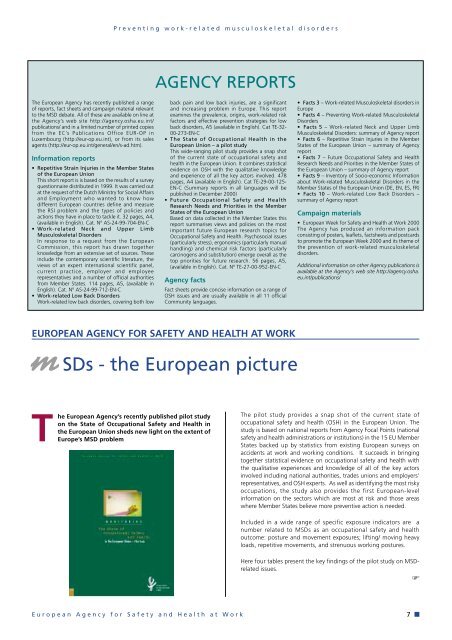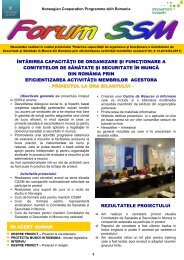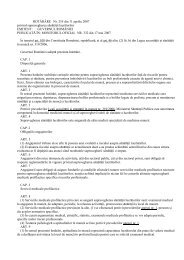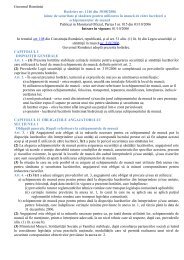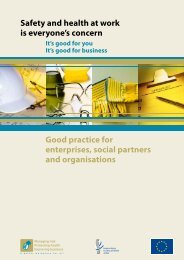Preventing work-related musculoskeletal disorders - European ...
Preventing work-related musculoskeletal disorders - European ...
Preventing work-related musculoskeletal disorders - European ...
Create successful ePaper yourself
Turn your PDF publications into a flip-book with our unique Google optimized e-Paper software.
<strong>Preventing</strong> <strong>work</strong>-<strong>related</strong> <strong>musculoskeletal</strong> <strong>disorders</strong><br />
AGENCY REPORTS<br />
The <strong>European</strong> Agency has recently published a range<br />
of reports, fact sheets and campaign material relevant<br />
to the MSD debate. All of these are available on line at<br />
the Agency’s web site http://agency.osha.eu.int/<br />
publications/ and in a limited number of printed copies<br />
from the EC’s Publications Office EUR-OP in<br />
Luxembourg (http://eur-op.eu.int), or from its sales<br />
agents (http://eur-op.eu.int/general/en/s-ad.htm).<br />
Information reports<br />
• Repetitive Strain Injuries in the Member States<br />
of the <strong>European</strong> Union<br />
This short report is is based on the results of a survey<br />
questionnaire distributed in 1999. It was carried out<br />
at the request of the Dutch Ministry for Social Affairs<br />
and Employment who wanted to know how<br />
different <strong>European</strong> countries define and measure<br />
the RSI problem and the types of policies and<br />
actions they have in place to tackle it. 32 pages, A4,<br />
(available in English). Cat. Nº AS-24-99-704-EN-C<br />
• Work-<strong>related</strong> Neck and Upper Limb<br />
Musculoskeletal Disorders<br />
In response to a request from the <strong>European</strong><br />
Commission, this report has drawn together<br />
knowledge from an extensive set of sources. These<br />
include the contemporary scientific literature, the<br />
views of an expert international scientific panel,<br />
current practice, employer and employee<br />
representatives and a number of official authorities<br />
from Member States. 114 pages, A5, (available in<br />
English). Cat. Nº AS-24-99-712-EN-C<br />
• Work-<strong>related</strong> Low Back Disorders<br />
Work-<strong>related</strong> low back <strong>disorders</strong>, covering both low<br />
back pain and low back injuries, are a significant<br />
and increasing problem in Europe. This report<br />
examines the prevalence, origins, <strong>work</strong>-<strong>related</strong> risk<br />
factors and effective prevention strategies for low<br />
back <strong>disorders</strong>, A5 (available in English). Cat TE-32-<br />
00-273-EN-C<br />
• The State of Occupational Health in the<br />
<strong>European</strong> Union – a pilot study<br />
This wide-ranging pilot study provides a snap shot<br />
of the current state of occupational safety and<br />
health in the <strong>European</strong> Union. It combines statistical<br />
evidence on OSH with the qualitative knowledge<br />
and experience of all the key actors involved. 478<br />
pages, A4 (available in English). Cat TE-29-00-125-<br />
EN-C (Summary reports in all languages will be<br />
published in December 2000)<br />
• Future Occupational Safety and Health<br />
Research Needs and Priorities in the Member<br />
States of the <strong>European</strong> Union<br />
Based on data collected in the Member States this<br />
report summarises views and policies on the most<br />
important future <strong>European</strong> research topics for<br />
Occupational Safety and Health. Psychosocial issues<br />
(particularly stress), ergonomics (particularly manual<br />
handling) and chemical risk factors (particularly<br />
carcinogens and substitution) emerge overall as the<br />
top priorities for future research. 56 pages, A5,<br />
(available in English). Cat. Nº TE-27-00-952-EN-C<br />
Agency facts<br />
Fact sheets provide concise information on a range of<br />
OSH issues and are usually available in all 11 official<br />
Community languages.<br />
• Facts 3 – Work-<strong>related</strong> Musculoskeletal <strong>disorders</strong> in<br />
Europe<br />
• Facts 4 – <strong>Preventing</strong> Work-<strong>related</strong> Musculoskeletal<br />
Disorders<br />
• Facts 5 – Work-<strong>related</strong> Neck and Upper Limb<br />
Musculoskeletal Disorders: summary of Agency report<br />
• Facts 6 – Repetitive Strain Injuries in the Member<br />
States of the <strong>European</strong> Union – summary of Agency<br />
report<br />
• Facts 7 – Future Occupational Safety and Health<br />
Research Needs and Priorities in the Member States of<br />
the <strong>European</strong> Union – summary of Agency report<br />
• Facts 9 – Inventory of Socio-economic Information<br />
about Work-<strong>related</strong> Musculoskeletal Disorders in the<br />
Member States of the <strong>European</strong> Union (DE, EN, ES, FR)<br />
• Facts 10 – Work-<strong>related</strong> Low Back Disorders –<br />
summary of Agency report<br />
Campaign materials<br />
• <strong>European</strong> Week for Safety and Health at Work 2000<br />
The Agency has produced an information pack<br />
consisting of posters, leaflets, factsheets and postcards<br />
to promote the <strong>European</strong> Week 2000 and its theme of<br />
the prevention of <strong>work</strong>-<strong>related</strong> <strong>musculoskeletal</strong><br />
<strong>disorders</strong>.<br />
Additional information on other Agency publications is<br />
available at the Agency’s web site http://agency.osha.<br />
eu.int/publications/<br />
EUROPEAN AGENCY FOR SAFETY AND HEALTH AT WORK<br />
m SDs - the <strong>European</strong> picture<br />
The <strong>European</strong> Agency’s recently published pilot study<br />
on the State of Occupational Safety and Health in<br />
the <strong>European</strong> Union sheds new light on the extent of<br />
Europe’s MSD problem<br />
The pilot study provides a snap shot of the current state of<br />
occupational safety and health (OSH) in the <strong>European</strong> Union. The<br />
study is based on national reports from Agency Focal Points (national<br />
safety and health administrations or institutions) in the 15 EU Member<br />
States backed up by statistics from existing <strong>European</strong> surveys on<br />
accidents at <strong>work</strong> and <strong>work</strong>ing conditions. It succeeds in bringing<br />
together statistical evidence on occupational safety and health with<br />
the qualitative experiences and knowledge of all of the key actors<br />
involved including national authorities, trades unions and employers’<br />
representatives, and OSH experts. As well as identifying the most risky<br />
occupations, the study also provides the first <strong>European</strong>-level<br />
information on the sectors which are most at risk and those areas<br />
where Member States believe more preventive action is needed.<br />
Included in a wide range of specific exposure indicators are a<br />
number <strong>related</strong> to MSDs as an occupational safety and health<br />
outcome: posture and movement exposures; lifting/ moving heavy<br />
loads, repetitive movements, and strenuous <strong>work</strong>ing postures.<br />
Here four tables present the key findings of the pilot study on MSD<strong>related</strong><br />
issues.<br />
<br />
<strong>European</strong> Agency for Safety and Health at Work<br />
7


